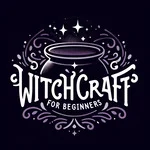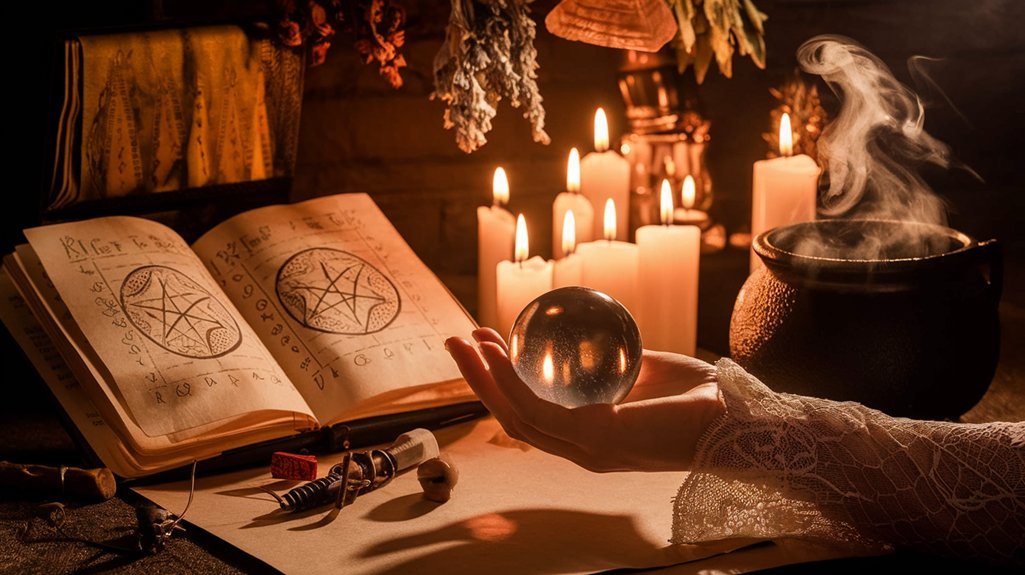As an Amazon Associate I earn from qualifying purchases.
You might not realize that witchcraft, often dismissed as mere superstition, has deep roots that stretch back to ancient cultures. These traditions offer a fascinating blend of spirituality, nature, and healing practices that have captivated humanity for centuries. As you ponder the intriguing evolution of these practices, consider how they persistently shape identities and empower individuals today. What keeps these age-old beliefs relevant in our modern, technologically-driven world?
Key Takeaways
- Witchcraft has ancient roots in shamanistic practices, nature worship, and efforts to explain natural phenomena.
- The Renaissance saw a transformation in witchcraft, blending it with alchemy and cultural revival.
- Witchcraft's resurgence in the 20th century was fueled by societal shifts and the New Age movement.
- Modern witchcraft emphasizes ethical guidelines, empowerment, and environmental awareness.
- Digital technology and globalization have introduced new rituals and expanded access to witchcraft practices.
The Roots of Witchcraft in Ancient Cultures
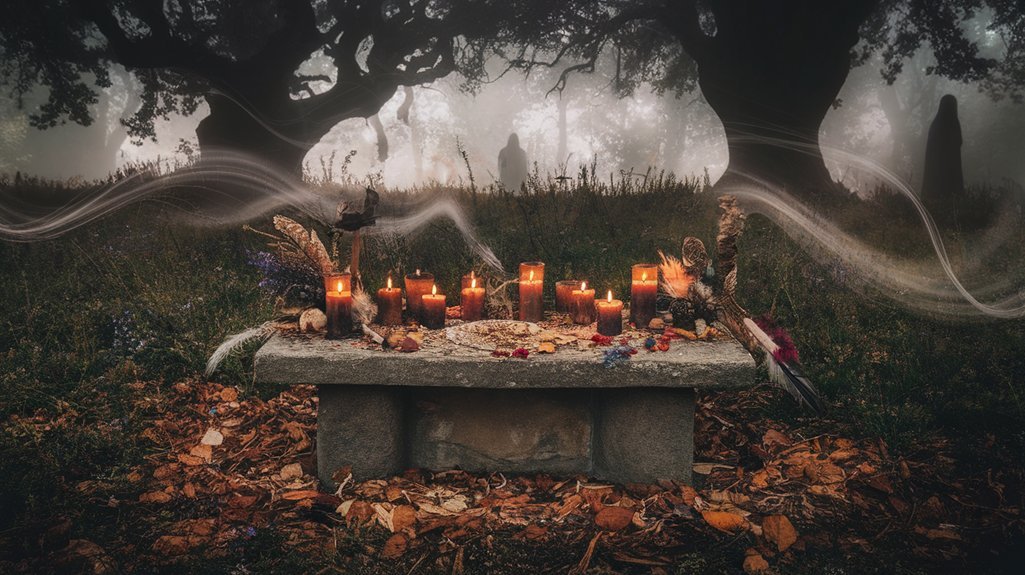
Although often shrouded in mystery and superstition, the roots of witchcraft stretch back to ancient cultures where it played a significant role in daily life and spirituality. You can see its influence in shamanistic practices, where shamans acted as intermediaries between the physical and spiritual realms. They utilized ancient rituals to harness magic systems, aiming to heal, protect, and guide their communities.
In these early societies, cultural beliefs intertwined with nature worship, emphasizing a profound spiritual connection with the earth. Magic wasn't merely about spells; it was a complex system reflecting the community's understanding of the universe. By engaging with these practices, you would recognize how ancient peoples sought to explain natural phenomena and maintain harmony with their environment.
Understanding these roots provides insight into how witchcraft evolved as a dynamic force, deeply embedded in human history and the perpetual quest for meaning and connection.
The Role of Witchcraft in Medieval Society
In medieval society, witchcraft held a complex and often contradictory role. You'd find it woven into the fabric of daily life, driven by medieval superstitions and societal fears. People saw witches as healers or midwives, yet they often became scapegoats during times of crisis. Their perceived power both fascinated and terrified communities, leading to their dual image as wise women and sinister figures.
- Dark forests: Places where witches were believed to gather, casting spells and concocting potions.
- Cottages in the woods: Homes of those who healed with herbs, yet faced suspicion and blame.
- Village squares: Locations of public accusations, where fear turned to hysteria.
- Moonlit nights: Times when tales of witches flying on broomsticks took hold of imaginations.
- Sacred groves: Spots considered both holy and tainted, where the line between magic and religion blurred.
Thus, witchcraft's role reflected the era's fears and beliefs.
The Influence of the Witch Trials on Modern Perceptions
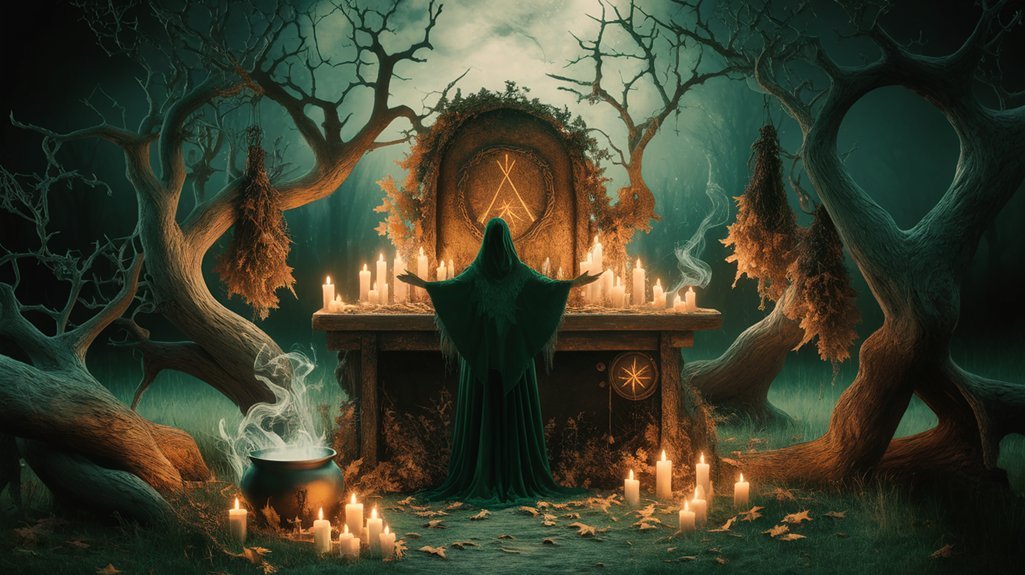
When you consider the witch trials, you'll notice their profound historical impact on how society views witchcraft today. These trials didn't just persecute individuals; they helped cement the enduring stereotypes of witches as sinister figures. By examining this legacy, you can better understand how these perceptions continue to shape modern cultural narratives.
Historical Impact of Trials
As you delve into the historical impact of witch trials, it's evident that these events have left an indelible mark on modern perceptions of justice and societal norms. The witch hunts fueled societal fear, creating a legacy of caution against mass hysteria and unjust persecution. These trials weren't just about punishing alleged witches; they reflected deeper societal anxieties. You see echoes of these events in today's legal systems and cultural narratives, where the scars of past injustices still influence decision-making and social dynamics.
Consider these historical scenes:
- Flickering candlelight illuminating stern faces in a dim courtroom.
- Accusatory fingers pointed at the vulnerable.
- The ominous silence before a verdict is declared.
- The relentless, haunting sound of a gavel.
- Communities torn apart by suspicion and fear.
Shaping Contemporary Witch Stereotypes
Although the witch trials of the past may seem like distant echoes, their influence on contemporary witch stereotypes is undeniable. These trials have shaped cultural representation, embedding fear imagery in media portrayal. You observe how historical context molds modern interpretations, with popular culture often highlighting sinister attributes. Yet, gender dynamics play a pivotal role, as societal perceptions historically cast women as primary targets. This legacy persists, complicating modern-day empowerment narratives. However, the witch's image isn't solely one of malevolence. Media increasingly explores complex characters, challenging outdated stereotypes. You see this shift as a reflection of evolving gender dynamics and a more nuanced understanding of witchcraft's historical roots. Consequently, witches symbolize both historical persecution and contemporary empowerment in cultural narratives.
The Evolution of Witchcraft in the Renaissance
During the Renaissance, witchcraft underwent a significant transformation, reflecting broader societal shifts and intellectual awakenings. You'd find that Renaissance magic intertwined with alchemical practices, aligning with the era's quest for knowledge. As you explore this period, notice how witchcraft became a part of the cultural revival, where new ideas and artistic expressions flourished. Witchcraft wasn't merely feared; it was studied and sometimes revered.
- Alchemists experimenting with potions and metals in dimly lit rooms.
- Artisans incorporating mystical symbols into their work, hinting at hidden knowledge.
- Philosophers debating the nature of magic, blending science and spirituality.
- Lavish Renaissance fairs showcasing theatrical performances of magical tales.
- Artists painting ethereal witches, capturing the imagination of the public.
These elements illustrate how witchcraft evolved during this time. They reveal a complex tapestry of belief and practice, where the mysterious harmonized with the intellectual spirit of the age. Understanding this evolution offers insights into the Renaissance's profound impact on witchcraft's enduring appeal.
The Resurgence of Witchcraft in the 20th Century
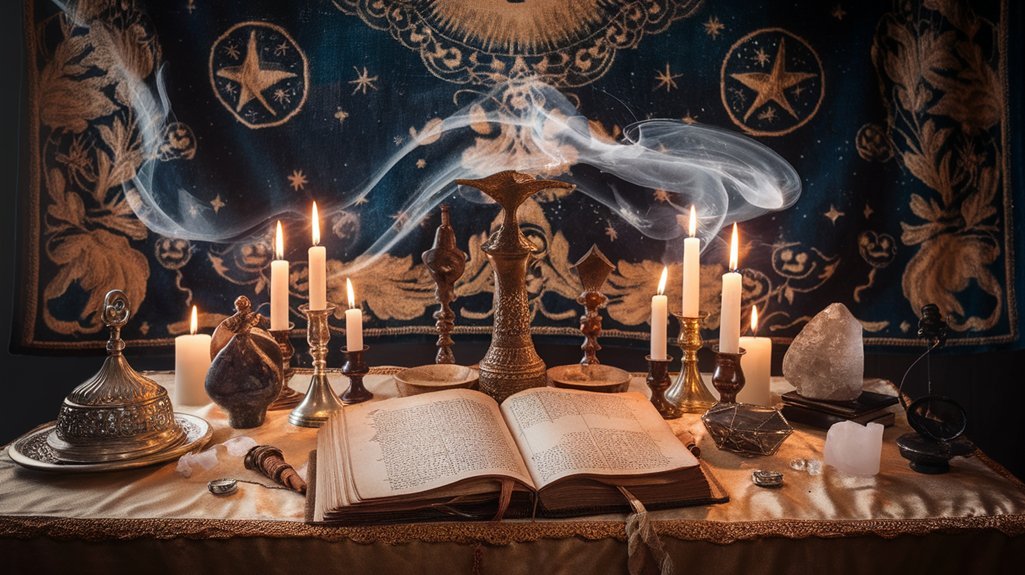
In the 20th century, witchcraft experienced a remarkable resurgence, driven by societal shifts and a renewed interest in personal spirituality. As you navigate through this era, you'll notice how the rise of the New Age movement played a pivotal role. People began seeking alternative spiritual paths that emphasized personal growth and connection to nature. This quest for deeper meaning in a rapidly modernizing world led many to rediscover witchcraft's ancient practices.
Witchcraft's presence in popular culture also surged, as books, music, and television embraced its themes. You might recall how the mystical allure of witches found its way into mainstream consciousness, influencing fashion, music, and even social movements. This cultural embrace helped dispel old stigmas, allowing people to explore witchcraft openly. By the end of the century, witchcraft had firmly reestablished itself, offering a spiritual refuge for those seeking empowerment and connection in an ever-changing world.
The Symbolism of Witches in Literature and Film
Witches have long captivated both literary and cinematic imaginations, serving as powerful symbols that reflect societal fears, desires, and transformations. When you explore witches in literature and film, you'll notice how they embody both the mystical and the misunderstood. They frequently emerge as literary archetypes, representing the unknown or the forbidden, challenging societal norms.
In cinematic portrayals, witches often oscillate between villainous figures and misunderstood heroines, prompting you to question the boundary between good and evil. Consider these evocative images:
- A shadowy forest, where secrets and spells intertwine.
- A cauldron bubbling with unknown brews.
- The cackle of a witch echoing through a stormy night.
- A young witch discovering her powers amidst societal scorn.
- Ancient tomes filled with cryptic symbols and spells.
Each portrayal invites you to delve deeper into the complexities of human nature and the timeless allure of power and mystery.
The Practices and Beliefs of Modern Witches

As you delve into the practices and beliefs of modern witches, you'll find a vibrant tapestry of traditions that blend ancient customs with contemporary spirituality. Ritual practices often involve herbal remedies and divination techniques, serving as a bridge to spiritual connections and personal empowerment. Modern beliefs emphasize ethical guidelines that encourage harmony with nature and environmental awareness, reflecting a deep respect for the Earth.
Community gatherings provide a space for witches to share creative expressions and support one another's spiritual journeys. These gatherings foster a sense of belonging and collective growth. Personal empowerment is a significant aspect, as witches focus on self-discovery and self-improvement, often through meditative practices or crafting personalized rituals.
Environmental awareness is crucial, as many modern witches advocate for sustainable living. By integrating these practices, modern witches not only honor ancient traditions but also adapt them to address contemporary needs and values, creating a dynamic, evolving practice.
The Intersection of Witchcraft and Feminism
While exploring the intersection of witchcraft and feminism, it becomes evident that both movements share a history rooted in challenging patriarchal norms and advocating for personal autonomy. Witchcraft, often seen as a form of spiritual activism, provides a platform for feminist empowerment through rituals and practices that emphasize gender equality and reclaiming power. This intersection is rich with historical context, where women accused of witchcraft were often those who defied societal expectations.
In modern practices, witchcraft continues to be a powerful tool for cultural representation and sisterhood solidarity. By embracing intersectional perspectives, witches today fight for social justice, drawing strength from:
- Ancient symbols reimagined for feminist empowerment.
- Moonlit gatherings celebrating sisterhood and shared purpose.
- Herbal concoctions symbolizing reclaiming power over one's body.
- Chants and invocations as acts of spiritual activism.
- Sacred circles fostering gender equality and connection.
Through these practices, witchcraft and feminism remain intertwined, inspiring new generations.
The Impact of Globalization on Witchcraft Traditions
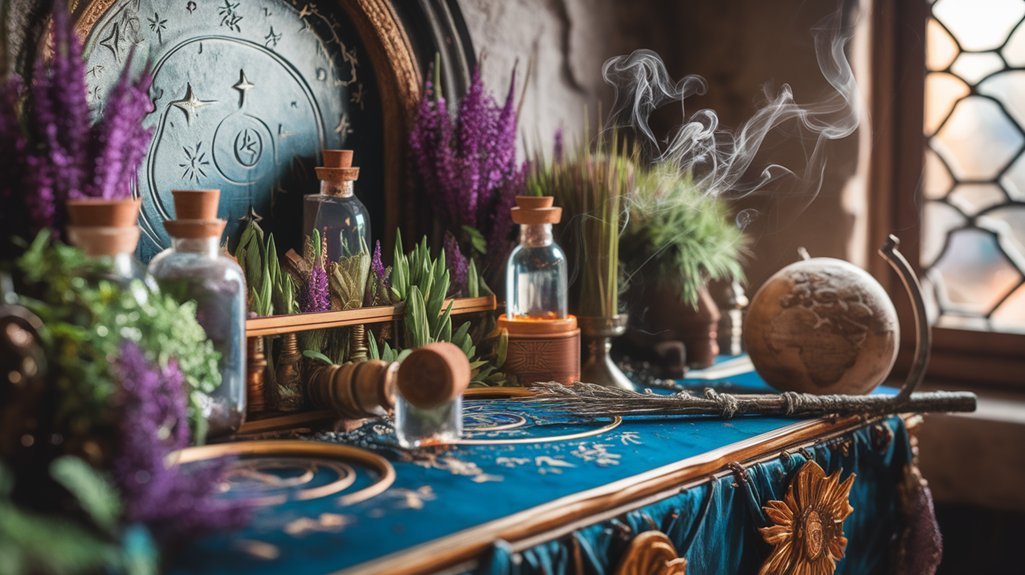
Though globalization has brought diverse cultures closer than ever before, it has also influenced traditional practices, including witchcraft. As you explore this ancient art, you'll notice the fascinating interplay between cultural exchange and spiritual globalization. Traditional practices once isolated to specific locales now interweave with global networks. This leads to modern adaptations and varied interpretations.
Consider this table to visualize the transformation:
| Element | Impact on Witchcraft |
|---|---|
| Cultural Exchange | Introduction of new symbols |
| Spiritual Globalization | Fusion of diverse rituals |
| Global Networks | Sharing of knowledge and practices |
Cross-cultural influences reshape witchcraft, infusing it with new vitality. You can see this in the blending of ingredients, symbols, and rituals, creating a dynamic tapestry. Yet, some purists argue these changes dilute authenticity. As you navigate this complex landscape, you'll find that globalization doesn't just homogenize; it also breathes life into witchcraft, ensuring its relevance in a rapidly changing world.
The Future of Witchcraft in a Technological World
Exploring the vibrant evolution of witchcraft amidst globalization reveals a compelling backdrop for its future in a technological world. In this age, digital witchcraft thrives as practitioners embrace tech-driven rituals. You'll discover online covens that connect individuals worldwide, forming communities through virtual spells and social media sorcery. Imagine harnessing augmented reality witchcraft to visualize ancient rites or using AI in rituals to tailor modern spellcasting techniques.
- Digital witchcraft: Where tradition meets innovation.
- Online covens: Global connections foster community and learning.
- Virtual spells: Cast spells with a click or tap.
- Social media sorcery: Share and learn through digital platforms.
- Augmented reality witchcraft: Experience rituals in immersive spaces.
E-commerce witchcraft offers tools and artifacts at your fingertips, blending ancient practices with technology. This cyber witchcraft practices a new dimension: one where tradition adapts, ensuring the enduring appeal of witchcraft in an ever-evolving digital landscape.
Frequently Asked Questions
How Did Witchcraft Influence Ancient Healing Practices?
You see witchcraft's influence in ancient healing through its herbal remedies and spiritual cleansing rituals. These practices intertwined belief and nature, guiding healers to harness plant properties and spiritual energy, creating holistic approaches that shaped early medicine.
Are There Specific Symbols Associated With Witchcraft Across Different Cultures?
You'll find specific symbols like the pentacle and broomstick holding unique symbolic meanings across cultures. Each symbol reflects cultural variations, showing how witchcraft's rich tapestry weaves diverse narratives while preserving its mystical essence and universal appeal.
How Do Modern Witches Utilize Technology in Their Practices?
You'd find modern witches harnessing technology by creating digital altars and connecting through online communities. These platforms offer a space for sharing rituals, learning, and fostering spiritual growth, blending ancient practices with contemporary tools seamlessly.
What Role Do Animals Play in Witchcraft Rituals?
In witchcraft, animal familiars symbolize guidance and protection. You'll find they often accompany witches in rituals, offering spiritual support. While ritual sacrifice is less common today, it historically represented a profound connection to the natural world.
How Has Witchcraft Influenced Fashion Trends Over Time?
You notice witchcraft aesthetics subtly shaping fashion trends through symbols like pentagrams and crescent moons. Fashion symbolism, rooted in mystery and individuality, draws inspiration from witchcraft's allure, influencing your style and personal expression over time.
Conclusion
As you explore the evolving landscape of witchcraft, you'll find it remains a vital part of contemporary culture. Did you know that over 1.5 million Americans identify as Wiccan or Pagan? This statistic highlights the growing relevance of witchcraft today. Its roots in ancient traditions, combined with modern feminist ideals and technological advancements, ensure its continued appeal. As society seeks meaning and connection, witchcraft's blend of autonomy and spirituality offers a compelling path forward.
Amazon and the Amazon logo are trademarks of Amazon.com, Inc, or its affiliates.

